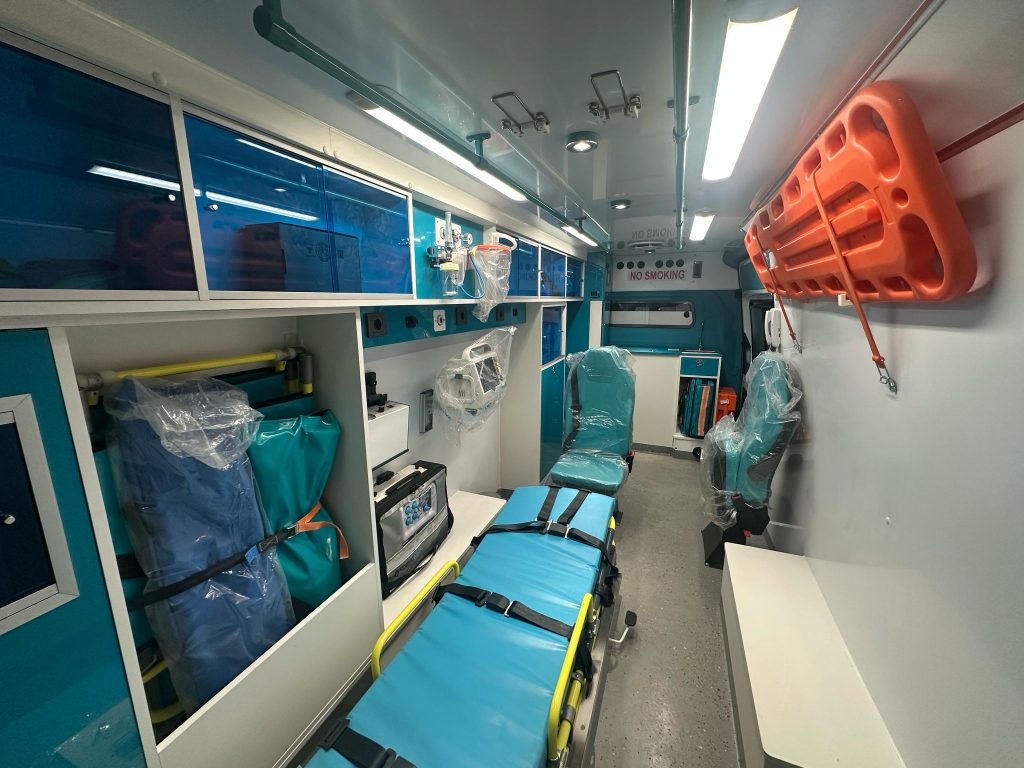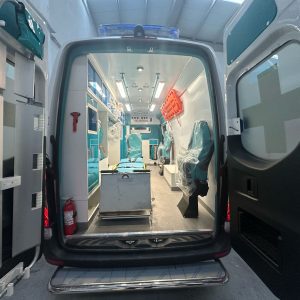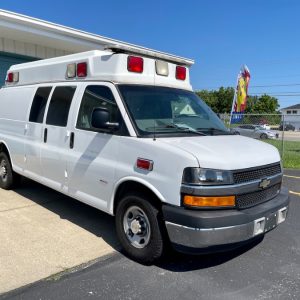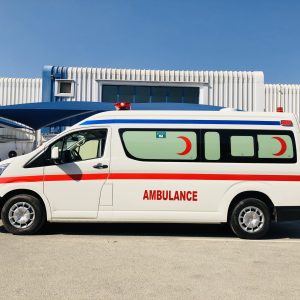1. Introduction to Emergency Medical Services (EMS) Vehicles
Fully Equipped Mercedes; An EMS vehicle refers to an Emergency Medical Services vehicle, which is crucial in the provision of medical, rescue, or any related assistance at the site of an incident that may involve a medical emergency, trauma, or any rescue activity. The primary purpose is to provide such assistance as soon as possible. The quicker the assistance is made available, the lesser its impact will be. Depending on the area and population density, the purpose of an EMS vehicle in such areas may have to be readapted to suit urban and rural environments. In populated countries and cities with good infrastructure, we have ambulances of different capacities, whereas in undeveloped or developing countries, there are special ambulances or mobile healthcare units in some areas equipped according to their needs. For better and special emergency needs, we have specialized EMS vehicles, which are called specialized EMS response units, that will be dispatched to the site. Emergency Medical Services (EMS) refers to medical services provided at the site of a medical emergency and during the transportation of a patient to a hospital for treatment. Recent advancements in the training of prehospital providers, along with scientific studies, have contributed to the necessity of medical care provided at some site other than a medical facility. Therefore, it can be stated that an EMS vehicle is not primarily used as a transport vehicle but as a mobile medical unit, specifically as advanced cardiac life support. These vehicles, with very high technical user equipment, are also equipped to carry out advanced procedures like ECG and intubation. As time passes, the role of an EMS vehicle and its design has substantially changed and further modified. It has changed from a simple transport to a mobile healthcare unit. It is a complete ambulatory intensive care unit. The user states the required bed while floating the tender. In some parts of India, specialized EMS vehicles are used in larger hospitals. As apparent from the above and considering future prospects, it appears to be a better opportunity to bid for the new techno-commercial solution for these well-equipped emergency specialized healthcare ambulances. The pre-hospital phase may take the form of emergency medical care during transport to an in-hospital care facility. EMS is generally governed and controlled at the local level within the country of origin. Some of the major players involved include healthcare facilities, as well as some government and non-government entities operating independently. In certain countries, regional politics delay the reformation of EMS systems. While retrospectively the number of ambulances and the ongoing activities in this field lead one to believe that well-equipped EMS vehicles are necessary for the welfare of a given society.
2. Evolution of Mercedes EMS Vehicles
Darley EMC Medium Duty Ambulance’s Mercedes EMS. Even before the founding of Mercedes-Benz, the company’s name has been synonymous with groundbreaking engineering and automotive innovation. Emergency Medical Services (EMS) vehicles have been around since the early 20th century, and a few used Mercedes engines for increased power. In the mid-1960s, a Mercedes marque sold in the U.S. was built for transporting injured surfers, serving as a precursor to modern EMS. Since this era, Mercedes brand vehicles have been used as livery or high-visibility corporate vehicles, often on a local basis or in very low volume.
In the event that EMS was needed, a respected and reliable brand image demanded a professional appearance and the associated build quality that came with the badge. Over the last 12 years, Mercedes and parent company Daimler have worked closely with Frazer, Ltd., who manufacture Type I, Type III, and Medium-Duty M1 commercial ambulances to ensure that the Mercedes-Benz product is fully engaged in the U.S. concept-to-completion of system ambulances. Archives reveal progress from the first prototype models released in 2010 to the current fully equipped 2023 Mercedes EMS vehicle, including the all-new ML-1 MSV across a 10-year span. Throughout the past 12 years, Mercedes has continued to maintain certification and exceed due to changing crash test regulations.
3. Key Features and Specifications of Fully Equipped Mercedes EMS Vehicles
Fully equipped Mercedes EMS vehicles are designed to provide first-class transportation of critically ill patients being transported to hospitals where they can receive the care they need. Integration of highly advanced medical equipment, not normally found on standard ambulances, makes these vehicles ideal for countries where ground transport over long distances to a specialized hospital is required. Mercedes fully equipped EMS vehicles deliver outstanding on-road performance, comfort and low vibration, top operational reliability, safety and fuel efficiency. Always ready to meet the mobility requirements of patients and medical crew, the top-quality Emergency Medical Service (EMS) vehicles integrate industry-leading medical equipment and technology appropriate for the provision of this service. The ambulance services can select the appropriate medical interior to serve the country’s needs. Also, non-standard right-hand and left-hand drive vehicles can be supplied. A vehicle that shall be in service for between 10 and 20 years without any requirement for increasing or replacement of the installed technology and equipment. These powerful top-quality Mercedes ambulances are designed for use as fully equipped emergency medical service (EMS) vehicles to provide critically ill patient transportation. Advanced performance, low vibration and high riding comfort, high safety and fuel efficiency are standard features of the vehicles. These units comprise part of an ongoing order by a Mercedes-Benz emergency vehicle dealership.
4. Market Analysis of Fully Equipped Mercedes EMS Vehicles
Analysis of Fully Equipped Mercedes EMS Vehicles Sales:
In order to clearly determine the market in which Mercedes’ fully equipped EMS vehicles need to compete, understanding what forces drive the demand in this market is crucial. Following this train of thought, EMS vehicles could be viewed as a means to an end: a mechanism aiding ambulance crews in their quest to efficiently attend, stabilize, and transport a patient to a care facility. It is as simple and as complicated as that. Not only are customer needs carefully researched, but different regions are known to have different tastes and needs as well, and thus the market has been further segmented. With careful knowledge of customer needs, it is possible to create more customer value, something competitors cannot easily copy, and something that should increase sales. Evidence available also suggests that vehicle tender vehicles could be built differently from those reported by the syndicated market research. For most of this document, attention is drawn to these vehicles marketed in this segment.
There are a number of companies that operate in the fully equipped EMS vehicle market globally. As of 2018, Demers is the market leader with a 30% share, followed by the Dodge Ram Promaster with a 21% share in the market. However, at an 8% share, Mercedes falls under other market leaders, such as Ford and Chevrolet. There is a substantial price difference between luxury end and run-of-the-mill vehicles. These are a combination of all the vehicles that are not mentioned. Considering these reports presents some opinion. The investigation is expected to provide a factual basis to help reveal Mercedes’ market share at the given time. If evidence supports this, it is expected to be viewed. The analysis should provide a good sense of competitive credentials relative to the remaining market. In 2018, the final figures of this report were popular marketing missions. Editorials covering these agendas reveal current trends impacting the overall ambulance market, including purchasing agencies’ purchasing models, studies of the community of care rules, and the impact of the pandemic and healthcare policy on the market and forecasts. Clearly, it can be seen that external pressures influence the work of the High Ground team. However, this agenda will concentrate on fully equipped vehicles that will transport patients, commercial trucks, or for-profit sectors, and non-profit/county hospitals only. Nevertheless, a brief explanation of these tendencies and the general ambulance economy in this segment could also give us some current market conditions.
5. Sales Strategies for Fully Equipped Mercedes EMS Vehicles
When selling fully equipped EMS vehicles, Mercedes-Benz finds it especially important to build relationships with healthcare providers, who are a major target customer, and public safety agencies and government agencies, particularly EMS authorities at the city and county levels, who are the usual purchasers of these specially designed vehicles. The sales team is composed of personnel with experience selling custom EMS vehicles or experience working with the EMS agencies. With an organization as global as Mercedes, establishing a well-connected sales force allows for the best access to the primary target market. Sales strategies focus on direct sales efforts, as well as accomplished partnerships to enhance market outreach. Currently, there are sales representatives available to the targeted region in North America as well as in various corporate regions. Partnerships are being fostered with local dealers, providing the emergency vehicle industry with the latest advances, as well as moving into international market opportunities. Showcasing the vehicle at trade shows and businesses is slated to expand a portion of incoming revenues. Marketing efforts are now ongoing to increase awareness of the Sprinter ambulance as the premier choice for fleet EMS vehicles. Mercedes American Emergency Vehicles targets urban markets, those most likely to purchase based on vehicle turnover. The Mercedes Metris and the Sprinter will be sent to numerous conferences, exhibits, and public safety shows. As the division expands, the EMS is being promoted with additional public service-themed events. Mercedes American Emergency Vehicles, along with additional team partnerships, have the ability to customize an ambulance to meet the requirements for any given situation. Our sales team has been trained in consultative strategy to guarantee that the vehicle proposed will assist the fire company in providing a comprehensive solution. Each vehicle is built for a unique customer, designed out of the proposals in preliminary consultation with the customer to ensure the creation of the emergency vehicle. Mercedes manufacture and equipment businesses have an opportunity to benefit from some synergies in the corporate company. Along with using the company’s major vehicle business to push the EMS sales, Mercedes American Emergency Vehicles will take advantage of this direct link. As the general manager and ambulance territory manager train about the Mercedes Sprinter, coordination will help consolidate efforts. Using information from Mercedes commercial vans, the EMS will be able to attend a global van business convention, allowing an array of international participants to network with potential ambulance buyers. This event will be used to introduce the customer to Mercedes American Emergency Vehicles and forge alliances that will bring Sprinter and Metris ambulances into further markets. Through the implementation of a tiered sales division structure, Mercedes-Benz will develop a readily available customer base. The structure would allow the EMS national sales manager and the state and local business dealer to submit a roster for the Smart Assist program. At the lowest level, with the entry of a coupon, firefighters in the top job would receive a monthly discount on the purchase of a new Mercedes vehicle. The Smart Assist system sets the basis for the creation of a known customer base.
6. Case Studies of Successful Mercedes EMS Vehicle Sales
Public Health Department Testimonial
When Harvey County Emergency Management set out to purchase a new ambulance, they were looking to meet a variety of needs in a single vehicle. From providing first responder services and transfers for area hospitals to being big and heavy enough to handle collisions with large farm equipment, they needed it all. So, HCEM Director Gary Denny approached the team with a unique solution: a Mercedes-Benz ambulance. They selected a 2020 AEV/American-built vehicle that comes fully equipped.
According to Denny, “Harvey County was in the market for a new ambulance to enhance our emergency response capabilities. The new Mercedes/Braun ambulances are an innovative and cost-effective way to deliver our product to the customer, and it provides for a smooth, quiet, and safe ride for our crews and their patients.” The new rig replaces what Denny has called “the worst running ambulance for two years running,” thanks to its powertrain, ease of maintenance on and off the lot, and components used. “This vehicle is a great solution to our needs! We look forward to a long-term working partnership, not just a purchase, with the EMS team,” he mentioned. Denny is thankful for an expanding and “excellent ongoing partnership” region-wide.
7. Challenges and Opportunities in the Mercedes EMS Vehicle Market
Fully equipped Mercedes EMS vehicle sales have declined in 2021. Although the market is expected to grow between now and 2028, there are some hindrances before the market sees an uptick in the growth curve. The first and foremost is the regulations that are frequently amended for production and quality standards. Continuous evolution in healthcare is ensuring that the changing consumer standards are defining future products, services, and operations. This, in turn, will help vehicle manufacturers carve out newer technologies, solutions, and product ranges. In such a demanding scenario, stakeholders need to be vigilant to stay informed and have useful data on gaining market shares. Mercedes can look at these opportunities and tailor their portfolio to these trends.
But not everyone is the same. The sudden surge in demand for alternative equipment has led to market saturation in some reports. Additionally, post-COVID-19, production and supply chain bottlenecks have arisen. Affordability has been a top priority for most manufacturers, leading to the ready availability of floor versions with little additional medical inventory. Furthermore, changing medical requirements in the industry, akin to consumer changes, will make the retrospective products irrelevant. However, as emergency response times become crucial, spending on emergency equipment increases. Thus, the development of next-generation products will open up the market doors for existing competitors; thus, electromagnetic stimulation system sales are profitable in the long run.
8. Technological Advancements in Fully Equipped Mercedes EMS Vehicles
Fully equipped Mercedes EMS vehicles are technological marvels. The advances in vehicle design, however, pale in comparison to the leaps in internal medical, communications, and overall operational capabilities they have accomplished. For example, the units we will be discussing have the first integrated telemedicine systems installed in the United States. This technology platform allows for real-time transmissions of vital patient data, live stream video images, cardiac monitors, ultrasounds, and data from blood chemistry lab studies to be shared with the emergency department prior to patient arrival. This allows specially trained physicians, emergency department nurses, and X-ray technologists to assist our EMS crew with any required interventions immediately upon arrival.
Each unit is designed around the needs and requests of the requesting fire or EMS unit. Where relevant and applicable, every latest safety and usable feature is combined and assessed to optimize services as best as possible while incorporating sustainable technology and ergonomics. Nearly all technologies installed are thoroughly researched prior to their inclusion and have been demonstrated to at least match the reduction of impactful productions and operations. These research and development operations have included establishing cutting-edge technologies, including replacing vehicles’ roof-mounted air conditioning systems with a system of suppression-cooling systems, the initial designs of which are now appearing throughout international markets. The following sections will discuss all aspects of care and equipment installed in a significant number of Mercyhealth’s laptops and medical touchpads. These tools are quickly shared to the patient’s electronic medical record for EMS professionals to download and relay the information to receiving hospitals. This equipment not only makes for faster interventions and saves time in laboratories, it also industrializes the weight of the vehicle through the one-touch equipment system with remote-controlled doors and loaded hydraulic ramps designed for working weight and capacity, hydraulic stretchers. All Mercyhealth medical stretchers are equipped with powered lift and caseworkers to prevent employee injury. All stretchers may also accommodate patients up to a specified weight. All supplies and equipment have been installed in non-corrosive materials for use in all elements. All are fair, in concurrence with the commercially available vendors.
9. Regulatory Framework and Compliance for Mercedes EMS Vehicles
11. Regulatory Framework and Compliance
As motor vehicles are somewhat unique in that they operate on a roadway and carry passengers, they are subject to a vast regulatory framework as well as unspecified standards and codes. Virtually every local, state, and federal regulating body has a say in how your vehicle is operated, from the design of the vehicle to the materials it is made from. The regulatory framework is so vast that transportation officials and the vehicle manufacturers have little to no idea as to its entirety.
The design and construction of vehicles used in emergency medical services are regulated through various means, all designed to keep the public and the patients’ health in mind. As Texas is on the cusp of joining the few states that address the vehicle and equipment, a few others require vans to be regulated, not cars. Ultimately, there is a clear intent to apply federal crash and safety standards to these vehicles, yet some interpretations have been allowed that lead to vans made after the initial interpretive ruling to not meet these standards until the 2019 model year. After they are constructed, they are to be certified as a “vehicle for hire,” much like an ambulance. As specially constructed vehicles, there are standards that must be met by the conversion of the vehicle into an emergency medical services transport. These standards cover all aspects of the vehicle construction to include the electrical, computer, oxygen, backup ventilation, refrigeration, and the heating, ventilation, and air conditioning system performance monitoring. Standards for occupant and hardware requirements on these same vehicles exist, yet the government does not require these standards to be met.
Where an EMS vehicle design is not specifically addressed, manufacturers look to accepted design and operational practice. Once motor vehicles are made, they must meet all state and federal requirements prior to being sold, registered, or titled for roadway operation. Furthermore, every ambulance, whether built on an assembled or custom chassis, must meet federal safety and equipment standards through a certification process before it can be sold or used for patient care. Ultimately, the manufacturer must ensure that the vehicle is in a state of construction compliance prior to its sale, not the owner, the operator, or vendor. Many regulatory codes, medical standards, and vehicle-specific regulations require ongoing compliance. Since these same standards to which vehicles designed for emergency services are subject to rapid review and change, companies must understand the regulatory process in addition to performing a component check on each change of their design. The most effective means to identify changes and requirements for the vehicles used in emergency services is to maintain active engagement with standard development organizations, government officials, and the regulatory process. The procurement process should include a review of the contracting agency’s requirements determination. This is a process that ensures that the customer reviews vehicles from various manufacturers based on the best proven designs and the lowest bidders. A company’s offerings should meet or exceed all aspects of a “best value” purchase.
10. Future Trends in the Fully Equipped Mercedes EMS Vehicle Industry
Future trends in the medically equipped EMS vehicle industry are anticipated to embrace advancements in artificial intelligence, machine learning, automation, and deep learning. The implementation of such technology has the potential to revolutionize how emergency response missions are carried out, while emphasizing the effectiveness and accuracy of emergency operational decision-making. The additive implementation of these technologies is anticipated to bring further advancements in resource management and adhere to consumer and administrative expectations for greater integration between the first point of patient contact EMS and acute care. The growing emphasis on emergency contact due to chronic and long-term conditions aligns with these advancements, specifically the growing trend in telehealth services and greater support for integrated and event-driven care of the patient. An additional trend is toward vehicle-to-everything technology in the design and functionality of EMS vehicles. This integration of patient-to-provider communication methods provides greater potential in connecting the vehicle to the evolving smart city ecosystem. It is anticipated that vehicles will have more and more capability to allow emergency responders to work seamlessly in telehealth, surveillance, and visual monitoring support. Decisions are actively being made in preparation for such an eventuality. A trend in sustainability is anticipated with a specific lean toward advancements in hybrid and increasing electrification options in the marketplace. Changes in legislation worldwide are increasing pressure on automotive companies, which need to produce more green technology to keep within the law. To this end, the emergence of advanced biofuels and hydrogen power are also on the agenda as forward-thinking technology trends in the market. Greater interplay between the provision of EMS and private vehicle manufacturers is thought to be on the cards to help with bringing costs and adoption of technology in line with market competition. Consumers and administrators increasingly expect high levels of customer interest in purchasers and aftercare for all types of vehicles, including emergency vehicles. EMS designs and functionality are thus shifting to offer high-spec modern design and technology. Robust mobile connectivity and data are growing, and their use for medical support on vehicles is becoming the next potential for direct-to-the-public software. With the trends stated in the previous sections, Mercedes Benz can be anticipated to remain at the top of its industry in fully equipped EMS vehicles. Social trends and recent legislation introduce artificial intelligence interest and investigation to allow criteria panel selection to identify the potential for the greatest energy saving. Given that this is vital to offer price-competitive vehicles effectively, the example developed emphasizes the importance of artificial intelligence. This EMS vehicle trend that uses connectivity is selling vehicle data to clients as a streaming source instead of a service. Data flowing directly to matrixEMSTM can trigger immediate action, decreasing time to the patient and time the patient waits before transfer to the next facility. Guidance as to the market trend that Mercedes Benz should adhere to using the Mercedes Benz trade market as a suitable product. The current trends show sales of fully equipped EMS vehicles occur at an average rate of 63 vehicles per year. The results for the most appropriate of the vehicles considered are as follows. The Mercedes Benz product can be anticipated to have demand for such a vehicle in amounts between 40 and 302 units per year.













